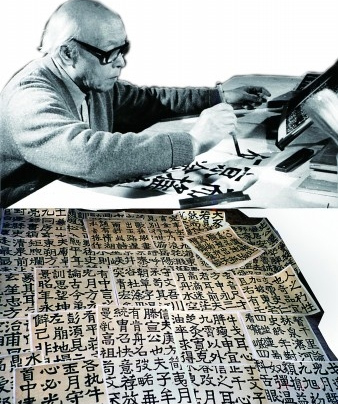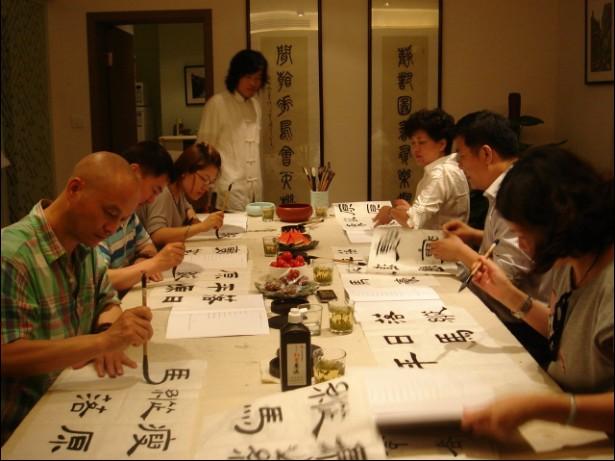For those who are learning calligraphy, there are many situations that will hinder our progress in the process of writing calligraphy and should be taboo. The main manifestations are the following six points.
First of all, avoid assembly line work.This is the most common problem encountered during calligraphy practice. Mr. Deng Sanmu once jokingly called it "cold and heat disease." When you are happy, you can write a thousand words a day without getting tired; when you are unhappy, you can put down your writing for ten and a half months without thinking about it. Such calligraphy practice of "three days of fishing and two days of drying nets" can be imagined. Song Mi Fu's "Hai Yue Ming Yan" "If you don't read for a day, you will feel thirsty. I think the ancients did not have a partial eclipse and waste books." To learn calligraphy, you must first be able to endure loneliness and have the spirit of perseverance. If you can persist in practicing calligraphy every day and keep the flow of water flowing, you will definitely achieve success.

Of course, as people's pace of life becomes faster and faster, calligraphers often encounter situations where they are too nervous at work or study to be able to write normally. Does this mean that it is impossible to learn calligraphy well? According to my personal experience, it is very important to learn calligraphy and read the calligraphy. It is also important to read the calligraphy. There is no time to read the calligraphy beforehand. As long as you regard calligraphy as your closest lover and think about her every day, will you still be far away from success?
The second taboo is "exposure to ten cold temperatures".Some calligraphers select a copybook and then immerse themselves in studying it one page a day until they finish writing. When I was writing, I didn’t observe carefully at all, and I didn’t make any analysis or comparison after writing. Whether it is the pen or the structure of the word "Lin", it is completely different from the word on the post. This kind of calligraphy practice can only be called "copying". Sun Guoting's "Shupu" says: "Those who observe it are more refined, and those who imitate it are more valuable." Therefore, you should write the same page of words every day, and don’t be greedy for too much. After reading it a dozen times and becoming more familiar with the original post, I can change the page. Before writing a post, you should read the post first (regarding the knowledge of post reading, "Chinese Fountain Pen Calligraphy" has many articles about it, you can refer to it). When writing a post, you must be calm and focused, and strive to follow the original post every bit, which is to achieve a state of "forgetfulness". After writing the post, compare it with the words in the ancient post, figure out the gains and losses, and find out the reasons. If there are certain words that you can't always write well, you can also bring them up for special writing until you are satisfied. Only in this way can we avoid the erroneous "copying" approach and make real progress.

The third taboo is to "change your mind when you see something different".Some people learn calligraphy. One day they learn Yan, tomorrow they learn Liu, and the day after tomorrow they change to Zhao. After changing and changing like this, I got a lot of posts, but often nothing was accomplished. You must be attentive when writing a post, and you must not be distracted or half-hearted. Of course, you can buy all the invitations from one family (for example, Yan Zhenqing’s Dharma acquisition invitations include: "Praise to the Portrait of Dongfang Shuo", "Duobao Pagoda Sensing Stele", "Magu Mountain Immortal Altar", "Yan Qin's Ceremony Stele", "Yan Family Temple Stele" , "Zi Shu Gao Shen Tie", etc.), focus on one post, study the others, and persist for a long time until you "understand it thoroughly", you should achieve something.
The four taboos are blind pursuit of "nature". Su Dongpo's poem says, "Poems don't ask for craftsmanship or fancy characters. Innocence is my teacher." It talks about the natural beauty of calligraphy. It is true that works rich in natural beauty may look ordinary and unpretentious, but in fact they contain profound truth and beauty. Some scholars who have a certain foundation know that there is a so-called "natural" principle, so they blindly pursue "nature", and what about the works they create? There is no emphasis on the use of pen or structure. It is all the author's "random words" and there is no rule at all. Mr. Zhu Yongfang once said in "Inkstone Travel Notes" in the 542nd issue of "Youth Calligraphy News": "Many people have begun to learn calligraphy and often think of following nature, but they don't know that there is no measure at all." Their understanding of nature is one-sided. and half-informed. They don't know that behind the natural beauty, there is great power, skill and meaning.
Naturally, one must have a strong foundation in traditional skills and have extremely solid Lintie skills. Mi Fu's career in collecting ancient calligraphy lasted forty years, and then he developed his own "innocent" calligraphy style. Wang Duo "Forty years ago, he tried his best to create his own characters. Forty years later, he had no intention of cooperating with his works and became famous" (Fu Shan's "Frost Red Niche Collection"). It can be seen that the realm of nature should come from artificiality and rules. When we learn calligraphy, we should first calm down, write the calligraphy seriously, and think carefully. We might as well be more "artificial" and less "natural".
Five taboos: Be unconventional and unconventional.In the "Chinese Idiom Dictionary", the word "conventional" means "deliberately doing something new in order to show oneself". In calligraphy, it means deliberately pursuing something "new, strange and strange". At present, there are many book competitions in various categories in our country, but some competitions have too much content. The "judges" of such competitions often don't know how to pretend to understand, and regard some so-called "masterpieces" that have no traditional skills but are "weird" as "innovations", which also leads some scholars to not follow the right track. When they select calligraphy, they ignore all the neat and orderly ones. They only select the infrequent, damaged or even the calligraphy with strange fonts as the examples for calligraphy practice. They want to seek "innovation" from these aspects in order to win the "big prize". This kind of learning method that refuses to start from the formal foundation will never produce good results. Mr. Zhang Xuguang emphasized that learning calligraphy must first be in place, and then taste. Don’t be afraid of not being innovative or modern enough when learning from the past. In fact, the more traditional something is, the more modern it is.

Six taboos: retreating when faced with difficulties.In the process of calligraphy practice, we will all encounter the same situation, that is, when we first start practicing calligraphy, we will always make rapid progress. I will be very happy when I see the continuous progress, and the more I write, the more energetic I will be. But after a period of time, you will find that your handwriting is getting worse and worse, and even "regressed". This phenomenon is the most common in the process of learning, and some people liken it to the "plateau phenomenon." Many people became pessimistic and disappointed because of their "retrograde". Later, they simply "retired" and stopped working.
In order to break through the "plateau", we must first know the reasons for its occurrence. Practicing calligraphy requires both hands and eyes. When I first started writing calligraphy, my appreciation level was not high, but the progress I made with my hands was very fast, so I felt that I was making progress. However, as time goes by, the level of appreciation will quickly improve, but the progress under the hands can never keep up with the eyes. This is often said to be "high eyes but low hands". The so-called "retrograde" means that the eyes have been able to further see some features of the calligraphy, but the hands are not skilled enough to grasp these features. This is a very natural phenomenon, and there is no need to be discouraged or even stop. Not learn.

So, how to break through the "plateau"? The most important thing is to strengthen your confidence. No matter whether you are progressing or regressing, you can grit your teeth and persevere. I believe that if you get through this hurdle, you will definitely have a bright future. On this basis, the following methods can also be adopted:
1. Follow the law. That is to say, you can put away the template you have found, and then find a copybook with a similar style to write on. After a period of time, you can change the original copybook and you will surely have new discoveries and experiences.
2. Reading method. When you can't continue writing, you can put away the paper and pen and read some calligraphy theory books instead, especially books about the inscriptions you are writing, to enrich your knowledge and broaden your horizons so that you can study further in the future.
3. Rest method. If you really can't write any more, just put away your pen, ink, copybook, etc., and don't think about it if you don't write. Leave it alone for a week or two , and then continue writing. I believe a new realm will unfold before your eyes.








